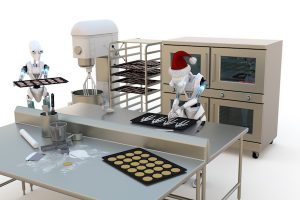Every day in kitchens throughout the world, people prepare breakfast, lunch and dinner. Often times it is as simple as popping something in the microwave or may involve preparing a meal from scratch. However, after a long, stressful day sometimes people just don’t want to bother. Imagine coming home and plopping all the ingredients into a kitchen robot? Yes, it’s true. Put all the ingredients into a robot, flip a switch, and supper is ready in 20 minutes, spiced and sauced according to the recipe.
Kitchen robots are already on the market, and it is predicted that 2019 will be the year that social and domestic robotic technology flourishes. The Boston Consulting Group predicts that the global spending on robots will hike up from over $15 million in 2010 to about $87 billion by 2025.
It seems unbelievable that robots have reached the domestic kitchen already. The day is coming soon when we will encounter a robotic kitchen in restaurants as well. Everyone has left a restaurant disappointed with their meal. With lots of work and often very little time at hand, chefs fail to meet our expectations from time to time. The steak is over cooked, the shrimp is not even hot, the soup tastes like water, etc.
This is where the concept of food automation comes in – to provide the best service to customers, stay relevant in today’s fast paced society, to build an impeccable reputation of quality and consistency, and to build on the image in a market where tech-savvy restaurateurs are embracing kitchen robots.
Restaurants across the world are already seeing savings with the help of modern technology. Digital Point-of-Sale systems, online food ordering applications, AR-based software providing customers with a video of the food preparation process and so on are common examples of tech meets food.
But, what about a robotic kitchen at restaurants? The concept is already in play:
- Spyce, a restaurant based in Boston, replaced human cooks with robot chefs to elevate their customers’ taste buds.
- A restaurant named Nagoya based in Japan aims to use kitchen robots to attract customers while driving labor efficiency.
- UK-based robotics company, Moley, has built a robotic kitchen that learns recipes, cooks and cleans up the mess.
- Even in developing countries like India, the technology is being wholeheartedly embraced.
All of the kitchen robots that have been developed and will continue to be developed require sensors and cameras to ensure that the food is cooked to the proper temperature and makes it to the pan and plate properly. No doubt many will have more than one vision source that requires accuracy. With a precision lens crafted by us, you can rest assured that the robot you are creating will see where the food must go, and not leave it on the counter or the floor.
Today’s society is used to automation in many aspects of life, and kitchen robots is another. Stay on the cutting edge with lenses sourced through Universe Optics.